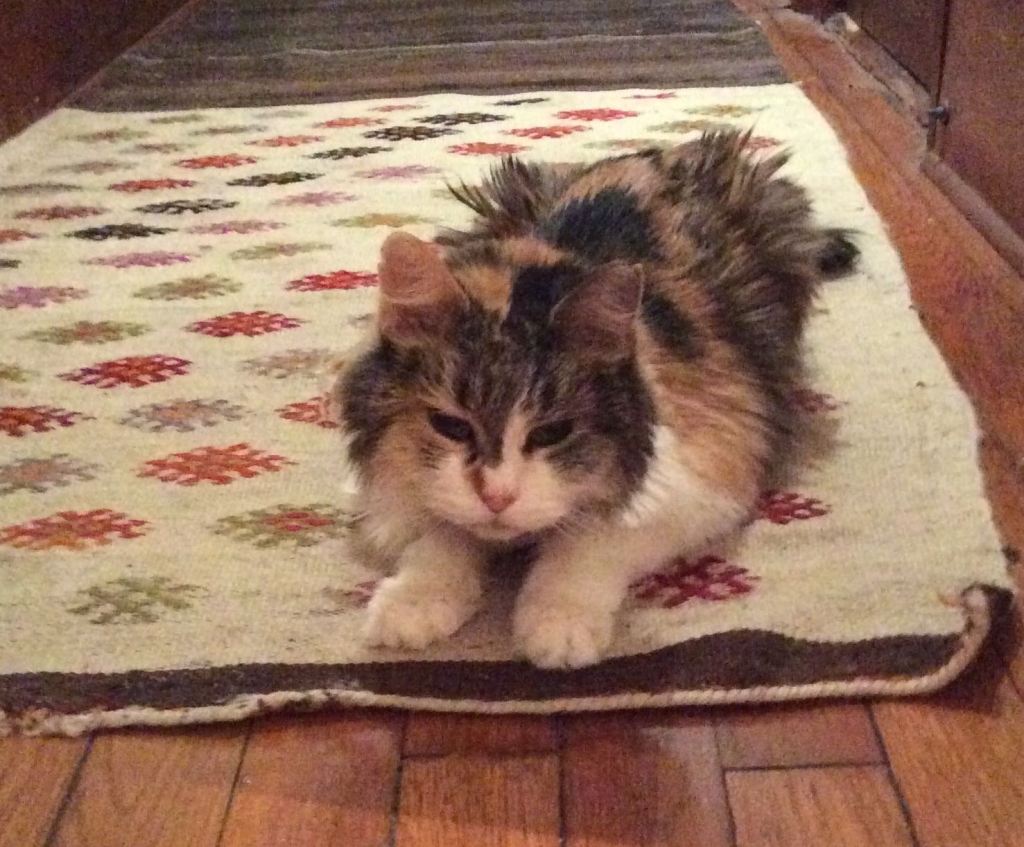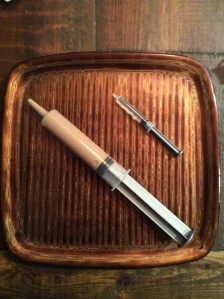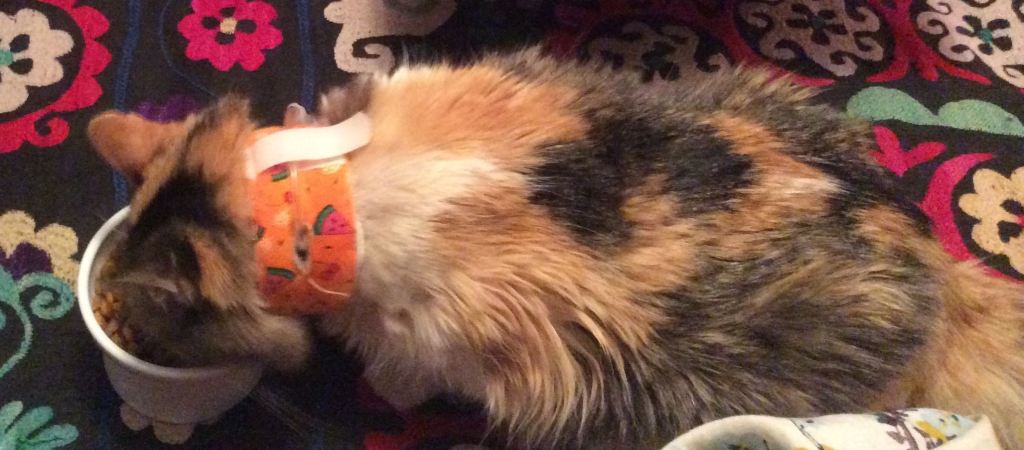STONES, SEIZURES, AND ESOPHAGEAL FEEDING TUBES
Mama was diagnosed with CKD in March 2015 at her annual exam. At that time her creatinine was 2.2 and the ultrasound (performed in search of IBD, given her weight loss) showed the shrunken kidneys typical of older cats, I was told. The vet could also see a kidney stone, though it wasn’t causing any obstruction. I left the appointment not particularly worried; Mama was 17 years old, and I wasn’t surprised to learn that her kidneys were showing their age. My main job, as I understood it, was to make sure she was eating sufficiently and keeping up her weight.
One month later, almost to the day, Mama crashed. I did not, however, know about crashing and so did not recognize the signs. She had been spending more time under the bed, but I didn’t recognize this as hiding (a symptom of feeling ill)—I just thought she had found herself a nice, new cave-like spot. And her energy and appetite levels had been low for quite some time, so those could not be indicators. It wasn’t until she threw up white, foamy vomit in the middle of the night that I thought hey, Mama doesn’t feel well. The next day, I watched her closely. She didn’t vomit again, but there was just something about the way she was sitting and the look on her face . . . I could tell she was uncomfortable. But it was only when she turned her back on me as I reached to pet her that I realized she needed to go to the vet. Our regular vet did not have an appointment open that day, but thankfully I knew, or rather felt on a gut level, that it could not wait any longer, so we went to our local emergency clinic.
At intake at the clinic they ran in-house labs, which showed her creatinine had risen to 6.7 and her BUN was over 140. She was also quite dehydrated. They recommended two to three days on IV fluids, with medications to address nausea and help her eat. I was worried, and a bit shocked by the projected cost of a three-day hospital stay (I now set aside a small portion of each paycheck toward any such future emergency), but I left feeling hopeful that the treatment would stabilize her.
I was thus unprepared for the call I got two days later from the internal medicine specialist, Dr. S., overseeing her case: Mama was looking bright and eating, but her creatinine had gone up to 7.8 and her left kidney was starting to dilate in a dangerous way. Oddly, the vet could not see any stones on the ultrasound, though they had been there a month before, but she nevertheless believed there was an obstruction. That was the only thing that could explain the combination of rising creatinine and dilation. There was nothing more that the clinic could do for Mama, Dr. S. said; if she was going to get through this, her only hope was likely a new surgery, called a subcutaneous ureteral bypass, that two specialists, Dr. B. and Dr. W., could perform at a veterinary research and teaching hospital uptown. Did I want a referral to meet with them about whether Mama was a good candidate for the procedure?
I went to the clinic to pick up Mama and the referral letter. Mama looked bright and alert and was very happy to see me. It was hard to believe she was in crisis. This was clearly a cat who had a lot of life in her still. The vet tech doing the discharge told me that Dr. S. was also calling the specialists uptown to let them know we were on our way. She was having trouble reaching them, I was told, but would keep trying. Well, it’s a good thing she called and kept calling: the specialists, the only two people in NYC who could perform this surgery, were on their way out to give a lecture on Long Island and then wouldn’t be back for several days. Thanks to that call, they waited for us to get there.
The next part moved very fast: at the hospital, Dr. B. explained the subcutaneous ureteral bypass (SUB) and its risks and prognosis, as well as the postsurgery care, which involved an esophageal feeding tube and regular check-ups to make sure the SUB device—essentially an artificial ureter—was in place and functioning properly. The team checked the ultrasound from the clinic and agreed that although no obstruction was visible, all signs pointed to one. They said if I agreed to the surgery, that before they placed the bypass device they would do a dye test to confirm obstruction and if by chance there wasn’t one, then they would not proceed. So . . . did we want to do it? They would stay and do it right then if I said yes, but otherwise they needed to go and would not be back until next week, at which time Mama might not be in good enough shape for surgery.
In the taxi ride home on the way from the hospital, I called my partner to let him know Mama was having an emergency procedure called a subcutaneous ureteral bypass. After he looked up this new term online, we realized that not only were the two vets doing Mama’s bypass some of the few vets in the world that could perform this surgery, but they were the ones who invented it. I had really liked Dr. B. and had felt good about leaving Mama in her hands, but I didn’t grasp until then that Mama was truly getting the best care possible—better care than I probably would ever get!
Dr. W. called about two hours later to report that the surgery had gone well and Mama’s creatinine had already dropped to 3.4 and they hoped to get it down to where it had been at diagnosis. Mama would be carefully monitored and someone would call me twice daily with updates. The creatinine did continue to drop—it was amazing, really—but the next evening brought some bad news: Mama had had a seizure, a bad one (a “grand mal seizure,” as it’s often called), and was showing “inappropriate neurological behavior.” In short, Mama had lost her vision and her ability to use her hind legs. The neurologist, I was told, had examined her and thought that permanent damage was unlikely; she just needed a few days to recover. The information was alarming, but there was something about the way that it was presented—as though grand mal seizures happen all the time and are no big deal (which I guess is true if you work in a hospital)—that left me unprepared for what I saw when I visited Mama the next day.
The vet tech laid her down on the exam table, limp and unmoving, and it seemed to me she was a cat halfway to dead. She would weakly lift her head when we talked to her, but it was obvious she couldn’t see. To the extent that she even tried to move at all, she could use only her front legs in sad attempts to drag herself forward. It’s a good thing that my partner could remain calm, petting her and talking to her, since all I could do was sob hysterically in the corner.
It took a few days more (above video shows second day after seizure), but Mama did recover, with the only remaining sign of that terrifying time being some mild coordination issues in her hind legs and one small—but still scary—seizure she had at home about two weeks after discharge. To ward off future seizures, she takes Keppra daily, but it is our hope that she will go six months seizure-free, and we can wean her off this medication.

One of the things to get used to after surgery was the esophageal feeding tube, or e-tube. As the name indicates, it is a tube placed in the esophagus, and it exits the body on the side of the cat’s neck. You can then feed, hydrate, and medicate your cat very easily through this tube.

It weirded us out at first to see a tube coming out Mama’s neck, and syringing large amounts of Pedialyte and blenderized wet food into the tube was surreal. Our anxiety in those first days even led to a false-alarm midnight trip to the emergency room when we thought that a gasket that had slipped down off the nozzle connection had somehow come from inside Mama and the tube must be coming out—all quite unreasonable in retrospect! But Mama did not mind the e-tube at all and in fact seemed to enjoy getting tube-fed, often purring and stretching out in the way she does when she is at her most relaxed. So it took us a few days to get used to it—and I’ll admit that I never cared for doing the stoma check and cleanings—but we really came to love that tube. In fact, we kept it in well past when she was eating on her own, since it made medicating and hydrating her so easy, and it felt like good insurance against any bout of inappetence. So we were sorry when it was finally time for it to go, partly because we just couldn’t beat a minor but chronic infection at the stoma and partly because at 16 weeks, it was just time (we were told to keep it in for 6–12 weeks). Although our non-CKD cat didn’t do as well with her e-tube due to her super-low platelet count, which caused a hematoma on her neck, I wouldn’t hesitate to recommend an e-tube to almost anyone whose cat needs a long course of assisted feeding.

Today, a little over four months since Mama’s drama erupted, her kidney values are beautiful, lower even than they were at diagnosis. There have been bumps along the way—including a urinary tract infection, hypertension, hypercalcemia, and chronic pancreatitis, not to mention her ferocious resistance to oral medication—and I know the future will bring its ups and downs, too. But Mama has many more good days than bad, and I hope we can keep it that way for some time to come. Given the team of smart and caring vets committed to her well-being, and the wisdom and support of the Tanya CKD forum, I am optimistic that this is possible. In the meantime, Mama’s purrs and headbutts of love remind me that there is no moment like the present, and the present calls for some serious chin scratches and ear rubs.
Return to home.
Go to resources.
Hi Allison, I’m in the CKD group as well and saw your link to Mama’s Drama in your reply to Pablo. Mama is just adorable! My Cassie is a bit jealous of that long, silky fur. Mama’s story is certainly a tribute to the great care we can give our kitties, with a little help from the vets of course. Thank you for sharing it here an on the forum.
Gay & Cassie
LikeLike
A heart warming story. Thankyou for sharing (from someone who may have to go down the same route)
LikeLike